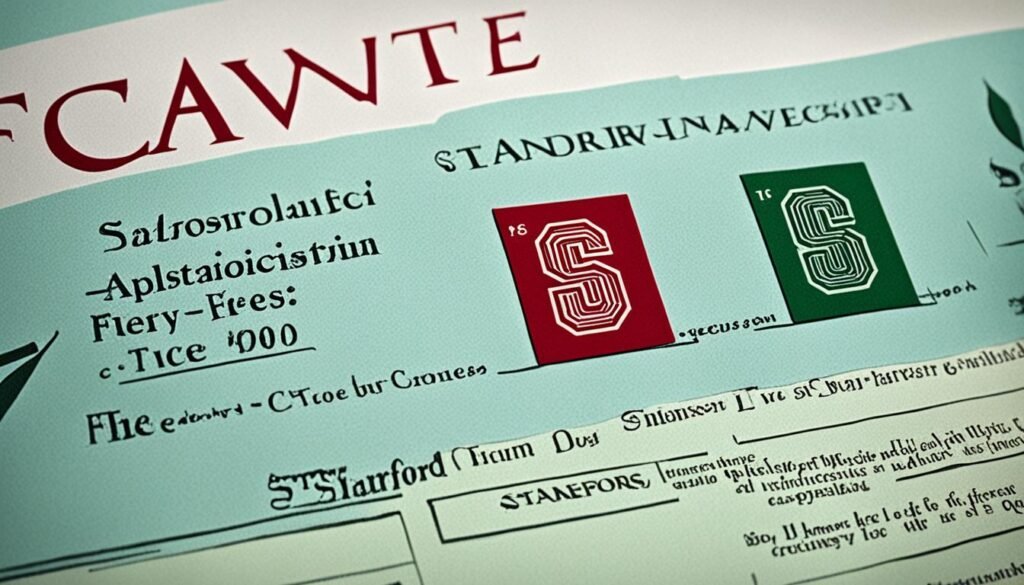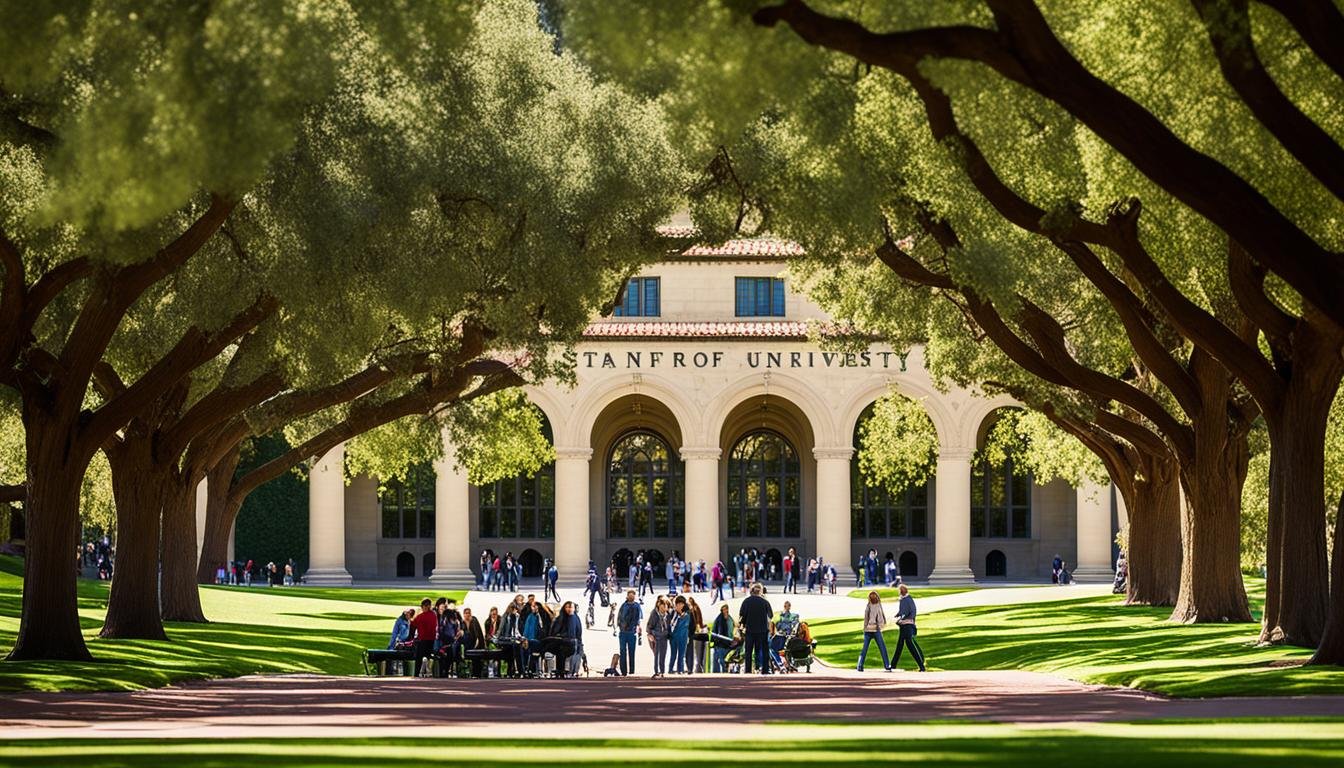Stanford University offers admission to exceptional students through a holistic application review process evaluating academic and extracurricular achievements. The application encourages applicants to reflect on their identity and what is important to them. Stanford approaches the admission process with sincere respect for each individual applicant and looks forward to learning about them through their application. Applicants are limited to a total of three applications for undergraduate admission, whether for first-year admission, transfer admission or a combination of both. If an applicant has submitted fewer than three applications to Stanford, they may reapply.
Key Takeaways
- Stanford University offers a holistic application review process that evaluates academic and extracurricular achievements.
- The application encourages applicants to reflect on their identity and what is important to them.
- Applicants are limited to a total of three applications for undergraduate admission.
- If an applicant has submitted fewer than three applications to Stanford, they may reapply.
- Stanford approaches the admission process with sincere respect for each individual applicant.
Introduction to Stanford University
Stanford University is one of the world’s leading research universities, known for its prestigious reputation, innovative spirit, and commitment to advancing knowledge for the public welfare. The university was founded in 1885 by former California Governor and U.S. Senator Leland Stanford and his wife Jane Stanford, with the mission of “promoting the public welfare by exercising an influence on behalf of humanity and civilization.” Stanford is located in Palo Alto, California, in the heart of the San Francisco Bay Area, and is composed of seven schools offering both undergraduate and graduate programs.
Stanford’s Prestigious Reputation
The university is consistently ranked among the top universities in the world, including in the QS World University Rankings. Stanford has produced numerous Nobel laureates, Turing Award winners, and other notable alumni who have made significant contributions to various fields, including politics, business, science, and the arts.
Stanford’s Mission and Values
Stanford University’s mission is to “promote the public welfare by exercising an influence on behalf of humanity and civilization.” The university’s values are rooted in the legacy of its founders, Leland Stanford and Jane Stanford, who envisioned an institution that would advance knowledge and serve the greater good. This commitment to public service and the betterment of humanity is woven into the fabric of Stanford’s academic programs, research initiatives, and extracurricular opportunities.
Overview of the Admission Process
Stanford University’s admission process is highly competitive, with the university receiving thousands of applications each year from exceptional students seeking to join its vibrant community. The admission committee evaluates each applicant holistically, considering their academic achievements, extracurricular involvement, personal qualities, and potential to contribute to the university’s diverse and dynamic campus environment.
First-Year Applicant Requirements and Deadlines

Prospective first-year applicants to Stanford University must submit a comprehensive application package to be considered for admission. This includes the Common Application, a non-refundable $90 application fee or request for a fee waiver, and standardized test scores from either the ACT or SAT (test-optional). Additionally, applicants must provide a School Report form and counselor letter of recommendation, official high school transcripts, and two letters of recommendation from teachers.
Required Application Components
The required application components for first-year applicants to Stanford University are as follows:
- Common Application
- $90 non-refundable application fee or fee waiver request
- ACT or SAT test scores (test-optional)
- School Report form and counselor letter of recommendation
- Official high school transcript(s) or academic results
- Two letters of recommendation from teachers
- Midyear transcript (due by February 15)
Application Deadlines
Stanford University offers two application deadlines for first-year applicants:
- Restrictive Early Action: October 15
- Regular Decision: November 1
It’s important to note that Stanford reserves the right to evaluate an application and render a final decision even if all pieces of the application have not been received.
Regular Decision and Restrictive Early Action

Stanford University offers two application plans for first-year applicants: Regular Decision and Restrictive Early Action. The Regular Decision deadline is January 5, with decisions released in early April and a reply date of May 1. The Restrictive Early Action deadline is October 15, with decisions released in mid-December and a reply date of May 1. Restrictive Early Action is a non-binding program, meaning applicants can apply to other non-binding early action programs but cannot apply to other early decision programs.
The Regular Decision and Restrictive Early Action application plans offer first-year applicants different timelines and decision schedules, allowing them to strategize their approach to the application process. Regardless of the plan chosen, Stanford’s admission committee carefully reviews each application to make decisions and notifications that align with the university’s commitment to holistic evaluation and identifying talented individuals who can contribute to the campus community.
| Application Plan | Deadline | Notification | Reply Date |
|---|---|---|---|
| Regular Decision | January 5 | Early April | May 1 |
| Restrictive Early Action | October 15 | Mid-December | May 1 |
By offering these two distinct application plans, Stanford University provides prospective students with the flexibility to choose the option that best aligns with their individual needs and preferences, whether that be the earlier decision and notification timeline of Restrictive Early Action or the additional time for reflection and refinement offered by Regular Decision.
Academic Preparation for Stanford University

To secure a spot at the prestigious Stanford University, applicants must demonstrate a strong academic foundation. The university recommends that prospective undergraduate and graduate students complete a rigorous course load, focusing on core academic subjects such as English, mathematics, science, history, and foreign language. Challenging oneself with advanced classes in these humanities and sciences is crucial, as Stanford values interdisciplinary learning and a passion for research.
Recommended Coursework
Beyond the standard academic curriculum, Stanford encourages applicants to explore educational opportunities that align with their personal interests and academic strengths. This could include enrolling in advanced placement (AP) or International Baccalaureate (IB) courses, or even taking college-level classes during high school. By showcasing their ability to excel in a demanding academic environment, applicants can demonstrate their readiness for the rigors of a Stanford education.
Extracurricular Activities
Stanford University also values applicants who have actively engaged in extracurricular activities that reflect their intellectual curiosity, leadership skills, and commitment to their communities. Whether it’s participating in academic clubs, volunteering for local organizations, or pursuing creative hobbies, the university seeks students who have demonstrated a well-rounded set of interests and abilities beyond the classroom.
By carefully curating their academic and extracurricular experiences, applicants can showcase their potential to thrive in Stanford’s vibrant and diverse community, where collaboration, innovation, and a dedication to bettering the world are highly valued.
Application and Essays

Applying to Stanford University requires a comprehensive application process that includes both the Common Application and a set of supplemental essays. The Common Application serves as the foundation of the admission materials, providing applicants with an opportunity to share their personal statement and respond to several short-answer prompts.
Common Application
The Common Application is a widely-used platform that allows students to apply to multiple universities, including Stanford, with a single application. Through the Common Application, applicants can showcase their academic achievements, extracurricular involvement, and unique personal qualities. The personal statement, in particular, is an important component of the Common Application, as it allows applicants to reflect on their identity, experiences, and aspirations.
Stanford’s Supplemental Essays
In addition to the Common Application, Stanford University also requires applicants to complete a set of supplemental essays. These essays provide an opportunity for applicants to delve deeper into their academic and personal interests, as well as their fit for the university. The supplemental essays often explore the applicant’s engagement in extracurricular activities, their intellectual curiosity, and their potential contributions to the Stanford community.
The application and essay components are a crucial part of the holistic review process at Stanford, allowing the admission committee to gain a deeper understanding of each applicant’s unique qualities and potential to thrive in the university’s undergraduate programs. Through these materials, applicants can showcase their passions, values, and the diverse perspectives they can bring to the Stanford community.
Application Fee/Fee Waiver

Stanford University charges a non-refundable $90 application fee for first-year applicants. However, the university does offer fee waivers for applicants who demonstrate financial need. Eligible applicants can request a fee waiver through the Common Application or by contacting the admission office directly. The application fee helps cover the costs associated with the comprehensive review process, and the fee waiver ensures that financial constraints do not prevent qualified applicants from applying to Stanford.
Standardized Testing

Stanford University requires first-year applicants to submit either ACT or SAT test scores, though the university has a test-optional policy in place. Applicants who choose to submit standardized testing scores will have them considered as part of the holistic review process, but they are not the sole factor in the admission decision.
ACT or SAT Scores
Stanford recognizes that standardized test scores do not necessarily reflect an applicant’s full potential and academic abilities. The university encourages applicants to highlight their strengths and accomplishments through other components of the undergraduate application, such as essays, extracurricular activities, and recommendations.
Stanford’s Test-Optional Policy
In line with this philosophy, Stanford has implemented a test-optional policy, allowing applicants to choose whether or not to submit ACT or SAT test scores. This policy aims to ensure that the admission process remains accessible and equitable for all applicants, regardless of their access to standardized testing opportunities.
Transcript and Required School Forms

First-year applicants to Stanford University must submit a comprehensive set of academic records and supporting documents to provide the admission committee with a well-rounded understanding of their qualifications. At the core of this application process are the official transcripts and required school forms, which play a crucial role in evaluating an applicant’s potential to thrive in the university’s challenging academic environment.
Official Transcripts
Applicants must submit official transcripts from all secondary schools they have attended, regardless of the duration or type of enrollment. These transcripts offer a detailed overview of the applicant’s academic performance, including their course selection, grades, and overall grade point average (GPA). The transcript is a vital component of the application, as it allows the admission committee to assess the rigor and depth of an applicant’s academic preparation.
School Report and Counselor Letter
In addition to the official transcripts, first-year applicants must also provide a School Report form and a letter of recommendation from their high school counselor. The School Report offers valuable insights into the applicant’s academic abilities, extracurricular involvement, and personal qualities, complementing the information presented in the transcript. The counselor letter, written by a professional who has worked closely with the applicant, provides a unique perspective on the student’s strengths, achievements, and potential for success at Stanford.
Together, the official transcripts, School Report, and counselor letter form a comprehensive set of academic records that the Stanford admission committee carefully reviews to gain a holistic understanding of each applicant. These documents are essential in showcasing an applicant’s readiness for the university’s rigorous curriculum and their ability to contribute to the diverse and dynamic Stanford community.
Stanford University Interview

As part of the application process, Stanford University may invite select undergraduate applicants to participate in an optional interview. The interview provides an opportunity for the admission committee to learn more about the applicant’s background, interests, and fit for the university.
Interviews are conducted by alumni volunteers or admission staff and can take place in person, virtually, or over the phone. While the interview is not a required component of the application, it can be a valuable way for applicants to showcase their unique qualities and further demonstrate their interest in and suitability for Stanford.
| Interview Format | Description |
|---|---|
| In-Person | Applicants may be invited to visit the Stanford University campus for an in-person interview with an alumni volunteer or admission staff member. |
| Virtual | Interviews can also be conducted virtually, using video conferencing platforms, allowing applicants to participate from their own locations. |
| Phone | Some interviews may take place over the phone, providing a convenient option for applicants who are unable to meet in person or virtually. |
“The interview is a valuable opportunity for applicants to showcase their unique qualities and further demonstrate their interest in and suitability for Stanford University.”
Regardless of the interview format, the experience allows the admission committee to gain deeper insights into the applicant’s personality, intellectual curiosity, and potential contributions to the undergraduate community. While the interview is not a required component, it can be a meaningful addition to the application, helping to differentiate applicants and enhance the committee’s understanding of their fit for the university.
Arts Portfolio (Optional)

Applicants to Stanford University who have a strong background or talent in the arts, such as visual arts, performing arts, or creative writing, have the option to submit an arts portfolio as part of their application. The arts portfolio allows applicants to showcase their artistic abilities and achievements, which can be considered by the admission committee as part of the holistic review process. While the arts portfolio is not a required component of the application, it can be a valuable way for artistically inclined applicants to differentiate themselves and demonstrate their unique talents and potential contributions to the Stanford community.
The arts portfolio is an opportunity for undergraduate applicants to Stanford to highlight their creative skills and passion for the arts. Whether it’s a collection of paintings, photographs, or written works, or a recording of a musical or theatrical performance, the portfolio allows applicants to share their artistic vision and abilities with the admission committee. This optional component can provide valuable insight into an applicant’s interdisciplinary interests and their potential to enrich the diverse campus community at Stanford.
Submitting an arts portfolio is a chance for admission applicants to Stanford to stand out and showcase their unique talents beyond the traditional academic metrics. By highlighting their artistic endeavors, applicants can demonstrate their creativity, critical thinking, and dedication to their craft – all qualities that are highly valued by the university. The arts portfolio can be a powerful addition to the application, complementing the other required components and helping the admission committee gain a deeper understanding of the applicant’s holistic profile.
Also Read : Exploring Excellence: Top Medical Schools In The US
Conclusion
Applying to Stanford University is a comprehensive process that requires careful preparation and attention to detail. By understanding the university’s requirements, deadlines, and holistic review criteria, applicants can craft a compelling application that showcases their academic achievements, extracurricular involvement, and personal qualities. The application process encourages applicants to reflect on their identity, interests, and goals, and to demonstrate how they can contribute to the diverse and dynamic Stanford community.
Regardless of the outcome, the application experience can be a valuable opportunity for personal growth and self-discovery, helping applicants to better understand their strengths and aspirations. While the admission process may be competitive, the journey of self-reflection and exploration can be immensely rewarding, even for those who may not ultimately enroll at Stanford University.
By embracing the application process with dedication and authenticity, applicants can unlock valuable insights about themselves and their future pathways, ultimately positioning themselves for success, both within and beyond the walls of this prestigious institution.
FAQs
Q: How can I apply to Stanford University?
A: To apply to Stanford University, you need to complete the Common Application or Coalition Application, submit your high school transcripts, standardized test scores (SAT or ACT), letters of recommendation, and a personal essay. Make sure to check the specific requirements on Stanford’s admissions website.
Q: What is the campus life like at Stanford University?
A: Stanford University offers a vibrant campus life with numerous clubs, organizations, events, and activities for students to engage in. The campus is also known for its beautiful architecture and outdoor spaces.
Q: Do international students have the same opportunities for scholarships at Stanford?
A: Yes, international students can apply for scholarships and financial aid at Stanford University. There are various scholarship opportunities available for both domestic and international students.
Q: Who are some notable alumni of Stanford University?
A: Stanford University has a prestigious list of alumni, including successful entrepreneurs like Larry Page and Sergey Brin (Google co-founders), Elon Musk (CEO of Tesla and SpaceX), and politicians like Sandra Day O’Connor (retired Supreme Court Justice).
Q: What is the student life like at Stanford?
A: Student life at Stanford is diverse and enriching, with opportunities for academic growth, social engagement, and personal development. There are also various cultural events, sports activities, and community service opportunities for students.
Q: What is the acceptance rate at Stanford University?
A: The acceptance rate at Stanford University is typically around 4-5%, making it one of the most selective universities in the United States.
Q: How does Stanford University rank compared to other institutions?
A: Stanford University consistently ranks among the top universities in the world. It is known for its academic excellence, research contributions, and innovative programs across various fields.
